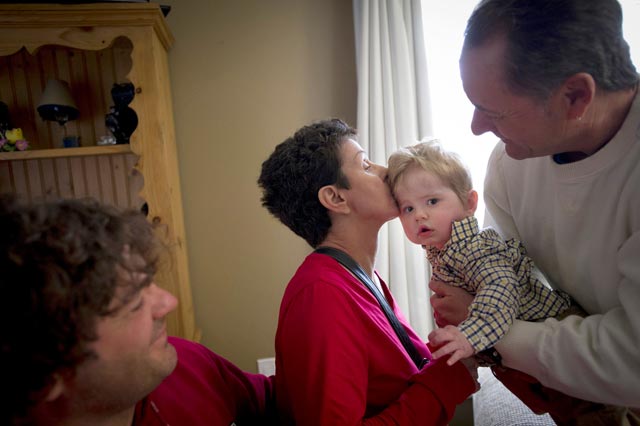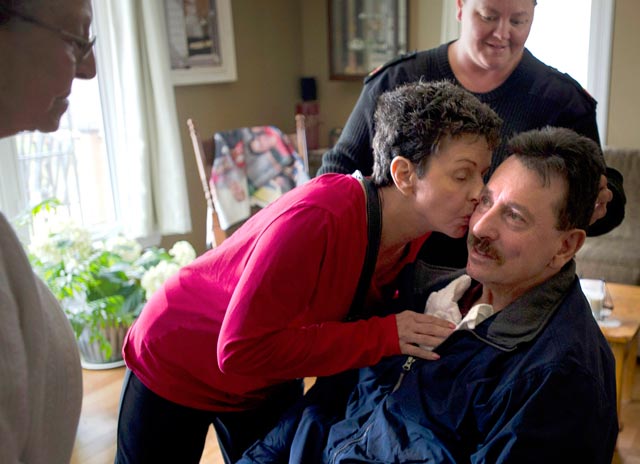Part 2
A family
secret
Photo Kim gives a nephew a kiss. The Teskes are a warm and unpretentious family in which hugging is endemic and nobody is a stranger for more than a minute. (Kevin Van Paassen for The Globe and Mail)
Even before Kim’s death wish, life was hard for the Teskes. Gwen and her husband, Larry, were from hard-working stock – she from Saskatchewan, he from Ontario. Larry was 42 when he died of testicular cancer, leaving a genetic secret that lay buried for 25 years: Huntington’s disease. Because Larry’s symptoms were masked by cancer, nobody suspected that he may have passed on a neurological time bomb to his children.
Back then, Gwen was more concerned about the present than the future. “I looked into the coffin and said, ‘How do I go on from here?’ ” she remembered thinking. “But the good Lord gives you strength,” she said. “I had to be there for my kids.” At 39, she had six children to support. The eldest, Brian, was 16. The youngest, Deanna, was 9. Gwen put in long hours running a restaurant at a truck stop to put food on the table. As soon as they were old enough, the kids worked there on weekends and after school.
Adversity was only part of the glue bonding the family, whose warmth and unpretentiousness remain obvious today. Hugging is endemic, humour is rarely barbed, no visit is intrusive and nobody is a stranger for more than a minute. “It’s all about my mother,” Stuart explained. “She’s the one who held us together. She’s a rock.”
None of the kids gave Gwen any trouble. “Not real trouble,” said Lynn Teske, who married Brian in 1978, when he was 21 and she was 19.
They had met a few years earlier at a high-school dance, but he had disappeared with a pal when the music stopped. “A girlfriend and I used to drive around Orangeville looking for him, until I found him,” she said, laughing at her sweet-sixteen boldness. Nearly 40 years later, she still won’t let him go.
Brian had gone to high school in nearby Mayfield, but he switched to Orangeville District Secondary School for Grade 12, “and then we were in the same school.” For nearly 20 years, life was busy but good. They had two children – a son, Jason, and a daughter, Sarah – and eventually Brian ran his own construction company with brother Stuart, digging basements and installing septic systems.
Video Brian’s family describes how he began to change. His hands started to shake, he became belligerent and would make strange decisions. He was the first in the family to be diagnosed with Huntington’s.
Everything changed as Brian approached 40. The easygoing, laid-back guy who never swore, who never spoke harshly or critically of others, became unpredictably belligerent. “There was no filter,” his wife said. “If he was thinking it, it came out.” Brian developed strange tics, like repeatedly shrugging his shoulders, and opening and closing his hands. One day, when he was sitting at the kitchen table, he picked up a glass and banged it down. After a few crashes on the tabletop, his wife asked him to stop. Bewildered, he asked, “Stop what?”
He also began making strange decisions, according to Stuart, a taciturn guy who fails to hide his tender heart and strong emotions. After 10 years in business with his brother, Stuart quit and moved to Florida to work with standard-bred horses. That’s where he met his wife, Rebecca, and their teenaged daughters, Victoria and Gabriella, were born.
Brian’s daughter tells much more graphic tales of the changes in her funny and generous father. As a teenager, Sarah lost count of the number of times he backed his Dodge Ram pickup into her Mazda, a car she was buying with her own money. “He’d put a hole right through the hood and I would be on my knees crying and he had no empathy at all.”
Eventually, things got so bad that the once-profitable business went broke, the Teskes lost their home and had to move in with relatives. Lynn finally persuaded her husband to go to a doctor, who prescribed antidepressants. “He walked around like he was drunk,” she said. “It was awful.” After repeated trips to the doctor, Brian was finally referred to a neurologist. Having checked his reflexes and asked him to do simple things like stick out his tongue, the specialist looked at Brian and said, “I think you have Huntington’s disease. I want you to consider going for a DNA test.”
Of course, Lynn immediately searched the Internet. “The more I read, the more I knew in my heart that that was what he had.” But denial came easily because nobody else in the family had Huntington’s – his mother was robust, and all his younger siblings seemed fine. Brian finally agreed to go for DNA testing in 1997, when he was 40. But it was another five years before he was willing to ask for the results of the simple blood test that would explain his increasingly bizarre physical and emotional behaviour.
“He didn’t want to know,” Lynn said.
This is a common reaction. At best, one in five of those at risk for Huntington’s are tested, because knowing doesn’t help when you have an incurable and largely untreatable disease. Lynn, nevertheless, tried to persuade him. “We can’t deal with what we don’t know,” she told Brian.
Photo The clan gathers, from left: Kim, brother Stuart, sisters Marlene and Deanna, mother Gwen, brother Brian and sister Dawn. Gwen wanted all her children across the country to get together one last time before Kim was gone. (Kevin Van Paassen for The Globe and Mail)
The entire family went to hear the results in July, 2002. By then, Brian was 45, Lynn was 43, Jason was 25 and Sarah was 22. Lynn said she remembers the doctor saying: “You know, Brian, when I open this envelope, I could be handing you a death sentence.” Even before the doctor read the diagnosis, Lynn knew that it would be positive because Brian had become that much worse.
Still, the confirmation was a shock. It took a year for everyone in the Teske clan to accept the news and to suspect that the disease had probably come from their long-dead father. Five of the six Teskes already had children; if they had Huntington’s, there was a 50-50 chance they had unwittingly passed it on – a horrifying thought for any parent. Brian’s daughter spent years obsessing about the disease, but refused to be tested. “I didn’t want a death sentence. I didn’t want to know at 24, 25 or 26 that I was going to be dying of Huntington’s,” Sarah said.
But that didn’t mean she didn’t worry: “If my arm had a twitch, I would think that was it.” She reached a point where the tension was so grinding that she realized knowing was better than not knowing. By then, she had decided that, if she were positive, she wouldn’t have children, although there is now a complicated and costly in vitro fertilization procedure that tests embryos and implants only those that are free of Huntington’s. Finally, in July, 2008, on a day Sarah could only describe in superlatives as “the best of her life,” she learned she was negative. Now, she is married and the mother of two small children.




